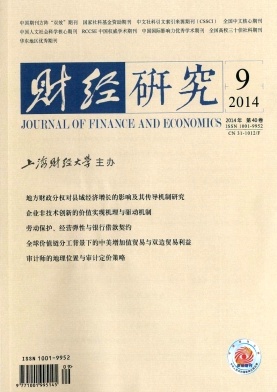可交易性折扣、价值转移与限售股解禁
财经研究 2014 年 第 40 卷第 09 期, 页码:86 - 96
摘要
参考文献
摘要
文章基于期权定价模型对可交易性折扣进行了建模,提出了可交易性价值转移假说,对限售股解禁的价格效应进行了研究,揭示了限售股解禁事件对股票价格的作用机理。研究发现:(1)根据可交易性折扣模型,随着限售期的逐渐缩短,流通股的可交易性价值将减少,限售股解禁实质上是一个可交易性价值从流通股向限售股转移的过程;(2)限售股解禁事件导致的累计异常收益主要形成于解禁前,并且呈现出显著的、稳定的、持续的下降趋势,而在解禁后略有回升;(3)较高的新增流通股相对比例、股价套利风险以及限售股股东减持意愿将加大限售股解禁事件对股票价格的负向影响。文章为限售股解禁导致的股票定价异象研究提供了新的理论视角,也为限售股解禁前的股票资产定价提供了理论依据,而且研究结论对于投资者把握股价趋势、优化投资决策具有一定的借鉴价值。
[1]李庆峰.基于MM定理的深化扩展研究——流通权分割影响公司价值吗?[J].金融研究,2008,(12):113-125.
[2]梁丽珍.分量回归下的中国股市价量关系研究[J].统计研究,2008,(12):73-78.
[3]廖理,刘碧波,郦金梁.道德风险、信息发现与市场有效性——来自于股权分置改革的证据[J].金融研究,2008,(4):146-160.
[4]刘力,王汀汀.不应忽略股票的流通权价值——兼论中国股票市场的二元股权结构问题[J].管理世界,2003,(9):46-51.
[5]邵新建,巫和懋.中国IPO中的机构投资者配售、锁定制度研究[J].管理世界,2009,(10):28-41.
[6]汪强.创业板公司创投股东减持行为及收益特点研究[J].证券市场导报,2011,(11):49-53.
[7]赵俊强,李湛.股权分置改革与股票全流通:一个基于需求价格理论的分析[J].生产力研究,2007,(11):48-49.
[8]赵自兵,陈金明,卫新江.中国A股股票需求弹性——基于全流通IPO锁定期解除效应的实证分析[J].金融研究,2010,(4):115-127.
[9]朱茶芬,陈超,李志文.信息优势、波动风险与大股东的选择性减持行为[J].浙江大学学报(人文社会科学版),2010,(2):164-173.
[10]Adrian T,Rosenberg J.Stock returns and volatility:Pricing the short-run and long-run components of market risk[J].Journal of Finance,2008,63(6):2997-3030.
[11]Akerlof G A.The market for“Lemons”:Quality uncertainty and the market mechanism[J].The Quarterly Journal of Economics,1970,84(3):488-500.
[12]Black F.Towards a fully automated exchange:PartⅠ[J].Financial Analyst Journal,1971,27(4):29-34.
[13]Biktimirov E N.The effect of demand on stock prices:Evidence from index fund rebalancing[J].Financial Review,2004,39(3):455-472.
[14]Brav A,Gompers P A.The role of lockups in initial public offerings[J].Review of Financial Studies,2003,16(1):1-29.
[15]Chaffe D B.Option pricing as a proxy for discount for lack of marketability in private company valuations[J].Business Valuation Review,1993,12(4):182-188.
[16]Field L C,Hanka G.The expiration of IPO share lockups[J].Journal of Finance,2001,56(2):471-500.
[17]Finnerty J D.The impact of stock transfer restrictions on the private placement discount[J].Financial Management,2013,42(3):575-609.
[18]Jiang G,Lee C,Zhang Y.Information uncertainty and expected returns[J].Review of Accounting Studies,2005,10(2):185-221.
[19]Kahl M,Liu J,Longstaff F A.Paper millionaires:How valuable is stock to a stockholder who is restricted from selling it?[J].Journal of Financial Economics,2003,67(3):385-410.
[20]Keasler T R.Underwriter lock-up releases,initial public offerings and after-market performance[J].Financial Review,2001,36(2):1-20.
[21]Longstaff F A.How much can marketability affect security values?[J].Journal of Finance,1995,50(5):1767-1774.
[22]Longstaff F A.Optimal portfolio choice and the valuation of illiquid securities[J].Review of Financial Studies,2001,14(2):407-431.
[23]Margrabe W.The value of an option to exchange one asset for another[J].Journal of Finance,1978,33(1):177-186.
[24]Odean T.Are investors reluctant to realize their losses?[J].Journal of Finance,1998,53(5):1775-1798.
[25]Ritchken P,Sankarasubramanian L,Vijh A M.The valuation of path dependent contracts on the average[J].Management Science,1993,39(10):1202-1213.
[26]Scholes M S.The market for securities:Substitution versus price pressure and the effects of information on share prices[J].Journal of Business,1972,45(2):179-211.
[27]Shefrin H,Statman M.The disposition to sell winners too early and ride losers too long:Theory and evidence[J].Journal of Finance,1985,40(3):779-790.
[28]Silber W L.Discounts on restricted stock:The impact of illiquidity on stock prices[J].Financial Analysts Journal,1991,47(4):60-64.
[2]梁丽珍.分量回归下的中国股市价量关系研究[J].统计研究,2008,(12):73-78.
[3]廖理,刘碧波,郦金梁.道德风险、信息发现与市场有效性——来自于股权分置改革的证据[J].金融研究,2008,(4):146-160.
[4]刘力,王汀汀.不应忽略股票的流通权价值——兼论中国股票市场的二元股权结构问题[J].管理世界,2003,(9):46-51.
[5]邵新建,巫和懋.中国IPO中的机构投资者配售、锁定制度研究[J].管理世界,2009,(10):28-41.
[6]汪强.创业板公司创投股东减持行为及收益特点研究[J].证券市场导报,2011,(11):49-53.
[7]赵俊强,李湛.股权分置改革与股票全流通:一个基于需求价格理论的分析[J].生产力研究,2007,(11):48-49.
[8]赵自兵,陈金明,卫新江.中国A股股票需求弹性——基于全流通IPO锁定期解除效应的实证分析[J].金融研究,2010,(4):115-127.
[9]朱茶芬,陈超,李志文.信息优势、波动风险与大股东的选择性减持行为[J].浙江大学学报(人文社会科学版),2010,(2):164-173.
[10]Adrian T,Rosenberg J.Stock returns and volatility:Pricing the short-run and long-run components of market risk[J].Journal of Finance,2008,63(6):2997-3030.
[11]Akerlof G A.The market for“Lemons”:Quality uncertainty and the market mechanism[J].The Quarterly Journal of Economics,1970,84(3):488-500.
[12]Black F.Towards a fully automated exchange:PartⅠ[J].Financial Analyst Journal,1971,27(4):29-34.
[13]Biktimirov E N.The effect of demand on stock prices:Evidence from index fund rebalancing[J].Financial Review,2004,39(3):455-472.
[14]Brav A,Gompers P A.The role of lockups in initial public offerings[J].Review of Financial Studies,2003,16(1):1-29.
[15]Chaffe D B.Option pricing as a proxy for discount for lack of marketability in private company valuations[J].Business Valuation Review,1993,12(4):182-188.
[16]Field L C,Hanka G.The expiration of IPO share lockups[J].Journal of Finance,2001,56(2):471-500.
[17]Finnerty J D.The impact of stock transfer restrictions on the private placement discount[J].Financial Management,2013,42(3):575-609.
[18]Jiang G,Lee C,Zhang Y.Information uncertainty and expected returns[J].Review of Accounting Studies,2005,10(2):185-221.
[19]Kahl M,Liu J,Longstaff F A.Paper millionaires:How valuable is stock to a stockholder who is restricted from selling it?[J].Journal of Financial Economics,2003,67(3):385-410.
[20]Keasler T R.Underwriter lock-up releases,initial public offerings and after-market performance[J].Financial Review,2001,36(2):1-20.
[21]Longstaff F A.How much can marketability affect security values?[J].Journal of Finance,1995,50(5):1767-1774.
[22]Longstaff F A.Optimal portfolio choice and the valuation of illiquid securities[J].Review of Financial Studies,2001,14(2):407-431.
[23]Margrabe W.The value of an option to exchange one asset for another[J].Journal of Finance,1978,33(1):177-186.
[24]Odean T.Are investors reluctant to realize their losses?[J].Journal of Finance,1998,53(5):1775-1798.
[25]Ritchken P,Sankarasubramanian L,Vijh A M.The valuation of path dependent contracts on the average[J].Management Science,1993,39(10):1202-1213.
[26]Scholes M S.The market for securities:Substitution versus price pressure and the effects of information on share prices[J].Journal of Business,1972,45(2):179-211.
[27]Shefrin H,Statman M.The disposition to sell winners too early and ride losers too long:Theory and evidence[J].Journal of Finance,1985,40(3):779-790.
[28]Silber W L.Discounts on restricted stock:The impact of illiquidity on stock prices[J].Financial Analysts Journal,1991,47(4):60-64.
引用本文
刘娥平, 唐舜. 可交易性折扣、价值转移与限售股解禁[J]. 财经研究, 2014, 40(9): 86–96.
导出参考文献,格式为:





 6910
6910  5002
5002

